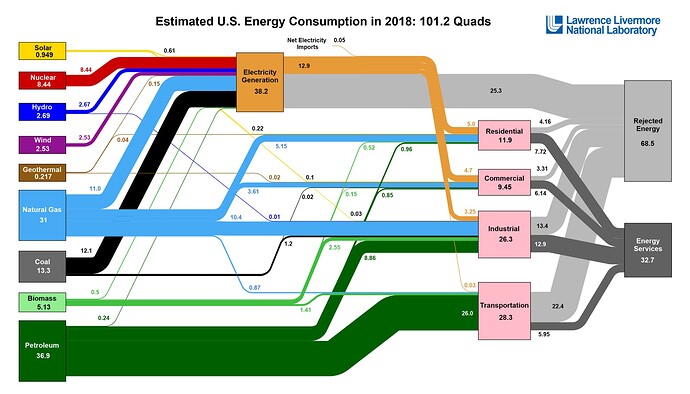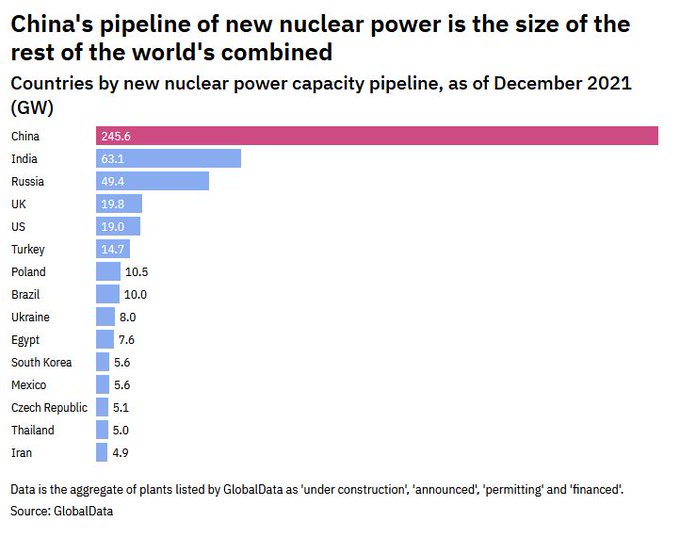Providing energy for a global economy in which billions of people in developing countries aspire to a lifestyle similar to that of Europe, North America, and East Asia is one of the most daunting challenges of the 21st century. Even with all of the potentials for improving efficiency in energy use, this will require a dramatic increase in energy production and consumption. The U.S. Energy Information Administration forecast in 2019 that global energy use would increase almost 50% between 2018 and 2050 (“EIA projects nearly 50% increase in world energy usage by 2050, led by growth in Asia”), and this does not account for increasing the standard of living for the burgeoning population of Africa.
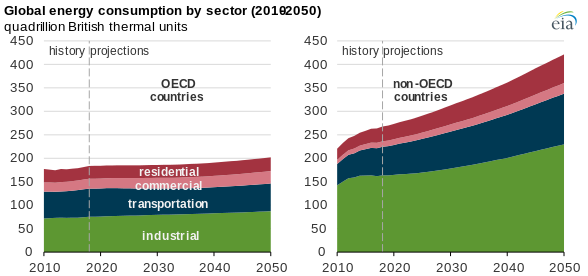
(Many different units are used to discuss large quantities of energy. The graph above uses “quads”, or quadrillion (10^{15}) British Thermal Units. The SI unit of energy is the joule, and a comparable quantity is the exajoule (EJ), with:
Smaller quantities of energy are sometimes expressed in terawatt hours, with one exajoule equal to around 278 terawatt hours.)
Meeting these needs will require the development of new energy resources and the means to deliver them worldwide. Currently, fossil fuels supply around 85% of world energy needs. Producing the additional energy with the same mix of fuels risks exhausting supplies recoverable at an affordable price, altering Earth’s climate due to releasing combustion products into the atmosphere, geopolitical instability due to concentration of resources in certain geographical regions, and pollution due to production, refining, transportation, and combustion of fuels. All of these concerns have motivated searches for other energy sources which do not run these risks.
The term of art for the goal of this quest is “sustainable energy”, which is often taken to imply “renewable energy” produced from sources such as hydroelectric, photoelectric solar, or wind power, all of which are ultimately ways of exploiting the energy of the Sun which, while neither renewable nor sustainable, may be expected to substantially exceed the time horizon of “policy makers”. Unfortunately, these resources are limited in quantity and either largely already exploited (hydroelectric) or intermittent (solar, wind) and poorly suited to provide reliable, inexpensive, “base load” power.
Using the United States as a proxy for the developed world, let’s look at an energy source and use flowchart for the U.S. in 2018 prepared by Lawrence Livermore National Laboratory, found and posted here in an earlier discussion by @drlorentz. (Click image to enlarge).
Since U.S. consumption happened to be 101.2 quads, you can read the numbers in the chart as percentages with only a little imprecision. While those speaking of “sustainable energy” often concentrate on sources of electricity, note that electricity currently accounts for less than 40% of energy use, with the balance direct consumption for space heating, transportation, industrial process heat, and other applications. Thus, any proposed energy source which produces electricity must, to replace current fossil fuel consumption, also imply the electrification of those uses which, in itself, may be a challenging prospect. Battery technology has only recently made electric automobiles marginally practical, and is far from that required to replace turbine engines for air transport. Electrification of other large bulk uses of energy will require dramatic expansion of the electrical grid, from bulk distribution through local delivery to consumers.
When its development began in the 1950s, power generated by nuclear fission was heralded as the energy source for the future. I am old enough to remember when the “atomic age” was used in a non-ironic fashion. The energy density of uranium, exploited optimally, is more than a million times greater than than of fossil fuels, and producing electricity from it emits no carbon dioxide, smoke, or noxious gas pollutants. Since its energy density is so great, nuclear power plants are compact and require little land compared to low density sources such as solar power farms or wind turbine arrays. Finally, the mining and refining of the small quantities of uranium fuel required and the modest quantities of radioactive waste produced have a small environmental impact compared to producing, transporting, and burning fossil fuels.
But due to historical accidents, lack of imagination, government bungling and regulation, incompetent engineering and operation leading to a small number of highly-visible accidents, fear mongering by media and ignorant advocates of other technologies or abandonment of our energy-intensive modern civilisation, nuclear fission power never achieved the ambitious goals (“too cheap to meter”) it originally seemed to promise.
Today, nuclear power is not usually considered among the “sustainable” alternatives to fossil fuels and, since it relies upon uranium as a fuel, of which a finite supply exists on Earth, is classified as “non-renewable” and hence not viable as a long-term energy source. But what do you mean “long-term”, anyway? Eventually, the Sun will burn out, after all, so even solar isn’t forever. Will ten thousand years or so do for now, until we can think of something better?
Energy “experts” scoff at the long-term prospects for nuclear fission power, observing that known worldwide reserves of uranium, used in present-day reactor designs, would suffice for only on the order of a century if nuclear power were to replace all primary power generation sources presently in use. But is this correct? In fact, this conclusion stems not from science and technology, but stupidity and timidity, and nuclear fission is a “bird in the hand” solution to the world’s energy problems awaiting only the courage and will to deploy it.
That is the conclusion by the authors of a paper with the same title as this post, “Nuclear Fission Fuel is Inexhaustible” [PDF, 8 pages], presented at the IEEE EIC Climate Change Conference in Ottawa, Canada in May 2006. Here is the abstract:
Nuclear fission energy is as inexhaustible as those energies usually termed “renewable”, such as hydro, wind, solar, and biomass. But, unlike the sum of these energies, nuclear fission energy has sufficient capacity to replace fossil fuels as they become scarce. Replacement of the current thermal variety of nuclear fission reactors with nuclear fission fast reactors, which are 100 times more fuel efficient, can dramatically extend nuclear fuel reserves. The contribution of uranium price to the cost of electricity generated by fast reactors, even if its price were the same as that of gold at US$14,000/kg, would be US$0.003/kWh of electricity generated. At that price, economically viable uranium reserves would be, for all practical purposes, inexhaustible. Uranium could power the world as far into the future as we are today from the dawn of civilization—more than 10,000 years ago. Fast reactors have distinct advantages in siting of plants, product transport and management of waste.
Let’s have a look at the argument. (First, note that when this paper was published in 2006, the price of gold was quoted as US$ 14,000/kg, or around US$ 435 per troy ounce, while in early 2022, gold is around US$ 1900 per troy ounce, or US$ 62,000/kg. So comparisons of “uranium at the price of gold” should keep that in mind. If uranium were to increase to near the present gold price, the quantity of economically viable ore would increase accordingly.)
Let’s begin by investigating replacing all fossil fuels with electricity generated from nuclear fission. The following table gives fuel consumption for energy generation worldwide in 2005 for the main areas of consumption in exajoules (which, for estimates like these, are close enough to quads that you can read them whichever way you prefer), the nuclear generated electricity required to replace that energy consumption, and the ratio of fossil fuel energy to nuclear electricity required for the replacement.
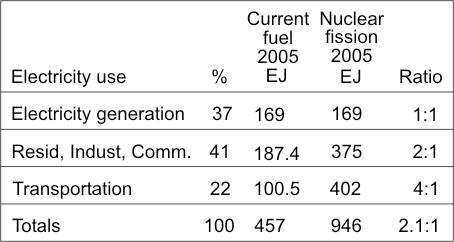
While electric generation can be replaced one for one, replacing space and process heat is assumed to require twice the amount of nuclear-generated electricity to account for the efficiency of generation, losses in transmission over the grid, and efficiency in conversion at the consumer location. For transportation, the ratio is estimated as four to one on the assumption that synthetic fuel is manufactured from the nuclear-generated electricity. Migration to vehicles directly powered by electricity may decrease this ratio. Adding these gives an estimate that it would take about twice the nuclear generating capacity to replace all applications of fossil fuels.
Next, we move on to estimating long-term global energy consumption assuming world population levels off around the year 2100 and that per capita energy consumption worldwide rises to its current level in Europe. This gives a rise from the present level to about 2500 exajoules (or quads) per year in 2200, remaining roughly constant thereafter. Combining with the earlier calculation, this implies replacing all fossil fuels with nuclear electricity will require around 5000 exajoules per year of generating capacity.
Now let us consider the design of the reactors used in nuclear electric power stations. Essentially all civil power stations in use worldwide, whether pressurised water, boiling water, graphite moderated, or other designs, are “thermal neutron reactors”. This means they employ a moderator substance such as water or graphite to slow down neutrons emitted by nuclear fission to increase the probability they will fission another uranium nucleus, thereby maintaining the chain reaction. This kind of reactor can only fission the U-235 isotope of uranium, which makes up just 0.71% of natural uranium mined from the Earth. This means that the rest, the 99.28% U-238, is “just along for the ride” and generates only a small amount of power through the secondary reaction of production of fissile plutonium-239 from absorbed neutrons. The upshot of this is that a thermal reactor extracts around 1% of the energy in its uranium fuel, with the rest being discarded as nuclear waste, requiring long-term storage. The “once-through” fuel cycle used in the United States, which does not even reprocess spent fuel to extract plutonium and unreacted U-235 to fabricate new fuel, is even less efficient, but we’ll assume sanity will eventually put an end to that stupidity, even in safetyland.
The main alternative to thermal reactors is variously called a “fast reactor” or “breeder reactor”. This design has been used in various reactors since the early days of nuclear research and, in fact, the first electrical power ever produced from nuclear energy was by a fast breeder reactor called EBR-I in the year 1951. A fast reactor does not use a moderator, but instead uses fast neutrons in higher enriched uranium to create fission which, by generating more neutrons per nucleus split, strike nuclei of U-238 and transmute them into plutonium. The reactor is called a “breeder” because it produces more fuel in the form of plutonium than it consumes. Spent fuel is reprocessed, extracting the plutonium (which, as a chemical process, is much simpler and less expensive than enriching uranium), that is fed back into the reactor to keep the cycle going. A mature fast breeder reactor and reprocessing cycle can extract essentially all of the energy in the natural uranium with which it is fed, or a hundred times more than a thermal reactor. As an extra benefit, the fast reactor “burns up” most of the long-lived fission products that make nuclear waste difficult to store and produces waste which is largely innocuous after around 500 years. Finally, most fast breeder designs use liquid metal as a coolant, which allows them to run at a higher temperature than water-cooled reactors, improving the thermal efficiency of steam production for power generation and (modestly) increasing electrical power output.
So, by moving from wasteful thermal reactors to fast breeders and using no more nuclear fuel, you can increase the estimated number of years nuclear fission can supply our energy needs by a factor of a hundred. But we’re not done yet.
Finally, consider where that uranium is coming from and what we’re paying for it. Natural uranium (0.71% U-235) is a commodity mined in a number of regions of the world, with production in 2019 amounting to 53,656 tonnes. Over the last decade, the price of natural uranium has fluctuated in the range between US$ 55/kg to US$ 110/kg. At those prices, the cost of uranium is almost a negligible component of the cost of nuclear-generated electricity. Even in thermal reactors, the cost of uranium accounts for only around US$0.0015/kWh, compared to an average retail price of electricity in the U.S. of about US$0.10/kWh.
Assume the price of uranium were to rise to the vicinity of US$14,000/kg, which was the price of gold when the paper was published in 2006. That would make economically viable the exploitation of very low-grade ore (or, if you prefer, high-grade dirt) containing only 1000 parts per million of uranium. It is estimated that at a price of US$14,000/kg for uranium, recoverable reserves would rise to between 40 and 50 times those estimated based on the current price of uranium.
And yet, even at this price, using the costly uranium in fast breeder reactors, the fuel cost of the electricity produced would be less than US$0.003/kWh.
Here are various estimates of the world supply of uranium with mine reserves calculated for its recent price. All numbers in this table are thousands, so the thermal reactor generation power potential from line 2, from an estimate made in 2000 by the Intergovernmental Panel on Climate Change (IPCC), should be read as 7700 exajoules, for 15,400,000 tonnes of uranium.
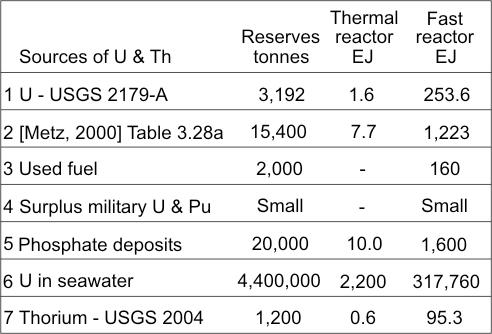
Going back to our estimate of 2500 exajoules per year for worldwide consumption replacing all fossil fuels after 2100, this doesn’t look very good—we’ll burn up the entire world’s uranium supply in just three years! But now, re-run the numbers assuming we replace the thermal reactors with fast breeders. Now we’re generating 1,223,000 exajoules from the same amount of uranium, providing power for almost 500 years. But the IPCC estimate was based upon uranium at around US$70/kg. If we let that rise to US$14,000 and assume that will increase the supply recoverable at that price by a factor of 40, we now have uranium sufficient for around 19,500 years of power!
And that’s not all. Another 20,000,000 tonnes of uranium are recoverable from phosphate deposits, and 4.4 billion tonnes more could potentially be recovered from seawater, should we need to start exploring that option, say, 15000 years in the future.
Every technology mentioned in this article, with the sole exception of recovery of uranium from seawater, which wouldn’t be needed for many millennia, already exists, has been demonstrated at scale, most over periods of decades. None requires breakthroughs in fundamental science, engineering that has not already been demonstrated long ago, or investments larger than those contemplated for other alternatives to fossil fuels.
The endpoint of the adoption of this energy path is the complete replacement of fossil fuels with nuclear power, reserving these valuable hydrocarbon resources as feedstocks for industry, total elimination of carbon emission from fuel consumption and pollution from power generation, heating, and transportation, and an assured supply of energy for a stable human population on Earth at developed nation standard of living for millennia into the future. As the authors conclude:
Many of the most serious problems facing human society have an important energy component. We do not know when peak production for fossil fuels will come, but we know that it will eventually arrive. Considering the importance of energy to humanity, it would be prudent to have a substantial program for the development and commissioning of fast nuclear fission reactors under way now in order to be adequately prepared.
Certainly, there are challenges in mass adoption of fast breeder reactors and electrification of all fossil fuel applications. Fast breeders, like any nuclear reactor, are a demanding technology which is intolerant of shoddy engineering, construction, maintenance, or operation. Mass deployment involves commerce in highly enriched nuclear fuels which can be diverted for nuclear weapons purposes. Siting and building the required generating stations, fuel reprocessing plants, and fuel fabrication facilities will probably be the object of intense “environmental” and “not in my backyard” opposition. Fear-mongers may be expected to gin up opposition to any human future which does not involve half-naked pithecanthropoids digging for grubs with dull sticks, and design, construction, management, and operation of these facilities will require teams of people recruited, evaluated, and compensated by merit, not metrics of “diversity”, “equity”, or “inclusion”.
Problems are inevitable, but problems have solutions. Humans are universal problem solvers—it’s what we do. A solution to the long-term supply of energy for human civilisation on Earth is at hand, and has been for years. It is up to us whether to grasp it, continue to pursue things which an evening’s calculation will show are folly, or chase dreams in the future which may never be realised.
Choose wisely.
